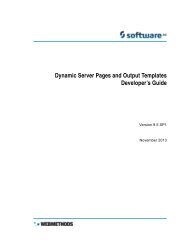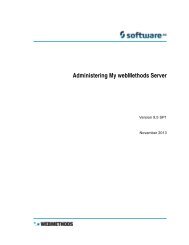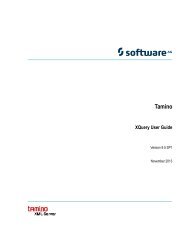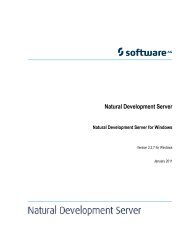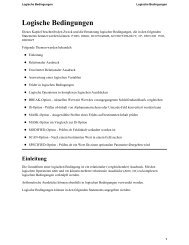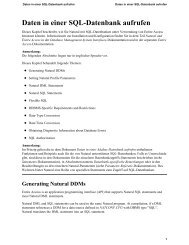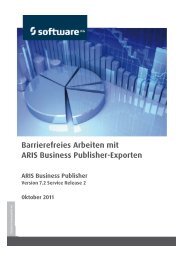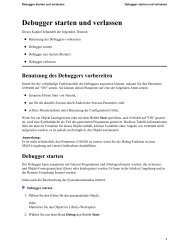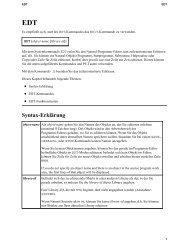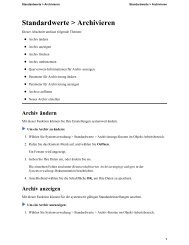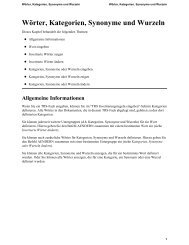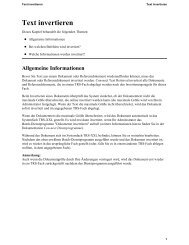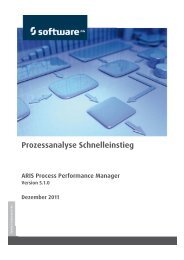PDF PAGE - Software AG Documentation
PDF PAGE - Software AG Documentation
PDF PAGE - Software AG Documentation
Create successful ePaper yourself
Turn your PDF publications into a flip-book with our unique Google optimized e-Paper software.
Introduction<br />
Introduction<br />
This documentation describes the installation and operation of the Adabas Bridge for DL/I (ADL)<br />
Interfaces for DL/I and Adabas applications. It will be needed in the phase following the conversion of<br />
DL/I databases into ADL files.<br />
The general installation of the ADL load and source libraries, the ADL Directory file and ADL Natural<br />
utilities are described in the ADL Installation documentation. This documentation also explains how to<br />
customize ADL to your site by means of specifying parameters for the ADL parameter module.<br />
The Adabas Bridge for DL/I consists of essentially six major functional units, namely<br />
ADL Data Base Conversion Utility<br />
ADL Directory file<br />
ADL Online Services<br />
CALLDLI Interface<br />
Consistency Interface<br />
ADL Installation Verification Package<br />
Introduction<br />
The ADL Data Base Conversion Utility allows you to convert your DL/I DBD and PSB descriptions into<br />
Adabas file descriptions and to convert data stored in DL/I data bases into data stored in Adabas files<br />
automatically. Whenever we talk about Adabas files which are based on the conversion of DL/I data bases<br />
we use the term "ADL file" to point out the special properties of these files. The information about the<br />
original DL/I structures and how they are translated into Adabas definitions is kept in the ADL Directory<br />
file. The contents of this file can be displayed with the ADL Online Services, which additionally allow<br />
you to maintain the ADL interfaces under CICS.<br />
The other two functional units of ADL are the CALLDLI Interface and the Consistency Interface. The<br />
CALLDLI Interface allows DL/I applications to access ADL files in the same way as original DL/I data<br />
bases. The Consistency Interface provides access to ADL files from Natural programs or with Adabas<br />
direct calls. This interface preserves the hierarchical structure of the data, which is of importance for<br />
ongoing DL/I applications.<br />
The ADL Installation Verification Package provides a DL/I application environment including an example<br />
database. The ADL Installation is verified and the conversion of the example database is practiced.<br />
Several DAZZLER test streams, Cobol and Assembler program are included as well as Natural<br />
applications for testing the ADL Consistency. Terms and concepts of DL/I and Adabas are introduced and<br />
it is shown how ADL maps one to the other. The ADL Installation Verification Package is described in<br />
details in the section ADL Installation Verification Package in the ADL Installation documentation.<br />
1
Introduction<br />
Figure 1: Functional units of ADL and their interrelation<br />
Figure 1 shows the individual functional units of ADL and their interrelation with DL/I, SQL and Natural<br />
applications.<br />
This documentation provides you with the information necessary to operate both the CALLDLI Interface<br />
and the Consistency Interface once ADL has been installed and the DL/I databases have been converted.<br />
This documentation is intended primarily for the system programmer responsible for the operation of<br />
Natural/Adabas and/or DL/I applications in batch and online systems. The section Using ADL Files with<br />
Natural/Adabas is of particular interest for application programmers. Similarly, the sections Managing<br />
ADL Files, ADL Online Services and Recovery and Restart Procedures will be of interest to DBAs.<br />
The first sections of this documentation cover the installation and operation of the ADL Interfaces for<br />
batch, CICS and IMS/TP.<br />
The section ADL Online Services describes how to examine the contents of the ADL Directory file and<br />
maintain the ADL Interfaces for CICS.<br />
The section Precompiler for "EXEC DLI" Commands describes how to use the ADL-supplied precompiler<br />
for "EXEC DLI" commands. Although this precompiler is not a direct part of the ADL Interfaces, it might<br />
be required in case DL/I and thus the High Level Programming Interface (HLPI) is not available.<br />
2<br />
Introduction
Operational Environments<br />
The section Using ADL Files with Natural/Adabas describes the way in which ADL files can be accessed<br />
by Natural/Adabas applications.<br />
The section Converting "Natural for DL/I" Programs describes what must be considered when converting<br />
an NDL program to a "normal" Natural/Adabas program.<br />
The section SQL Access to the Migrated Files describes how SQL applications can access the migrated<br />
data with the Adabas SQL Gateway.<br />
The section Debugging Aids - ADL Trace Facility covers the ADL Interfaces trace facility, which was<br />
designed to debug your applications as well as to track down problems related to the ADL Interfaces<br />
themselves.<br />
A program to test DL/I calls in batch, DAZZLER, is described in the section CALLDLI Test Program -<br />
DAZZLER.<br />
The management of converted DL/I databases is described in the section Managing ADL Files. As seen<br />
from an Adabas DBA point of view, there are a few things to be considered when managing ADL files<br />
with Adabas utilities. Also, this section explains how and in which way the DL/I structure or the Adabas<br />
file layout may be altered.<br />
The tuning of ADL is described in the section Performance Considerations.<br />
Obviously the conversion from DL/I to Adabas affects the restart and recovery scenarios. The section<br />
Recovery and Restart Procedures explains these changes.<br />
Most of the information contained in this documentation refers to both operating systems z/OS and z/VSE.<br />
Information which applies only to a single operating system is clearly marked as such.<br />
In order to install and operate the ADL Interfaces, a certain degree of knowledge of both data base<br />
systems, Adabas and DL/I, is required as well as a familiarity with the operating systems and TP monitors.<br />
This manual makes frequent usage of terms, synonyms, abbreviations and facts related to these systems.<br />
For clarity a glossary is provided with the ADL Messages and Codes documentation.<br />
This chapter covers the following topics:<br />
Operational Environments<br />
Other <strong>Documentation</strong> You May Need<br />
<strong>Documentation</strong> Related to non-S<strong>AG</strong> Products<br />
Operational Environments<br />
Introduction<br />
The Adabas Bridge for DL/I operates in both online and batch environments. The online environments<br />
currently supported are CICS Versions 3.2 and above. Programming languages which use the standard<br />
DL/I call interface, e.g. COBOL, Assembler, and PL/I, are supported in both online and batch.<br />
Operating system environments currently supported are: z/VSE and z/OS. The JCL/JCS examples given in<br />
this documentation are tailored for z/VSE and z/OS.<br />
3
Introduction<br />
Batch Operation<br />
Once all DL/I data bases accessed by a particular application program have been converted, the only other<br />
thing you need to do to operate the Adabas Bridge for DL/I in batch environments is to remove the JCL<br />
statements for the DL/I data bases and add input cards with ADARUN parameters. These are needed since<br />
the application has become an Adabas application program. The way in which the PSB name and<br />
application program names are specified, does not change. See the section Batch Installation and<br />
Operation for further details.<br />
Online Operation (CICS)<br />
Once all DL/I data bases have been converted, you may remove all JCL statements and FCT and ACT<br />
entries relating to them, as these are no longer required. Instead, you must generate a table of all the PSBs<br />
needed by the CICS application programs. Under z/OS CICS the ADL requires the installation of an SVC<br />
to operate properly. See the section CICS Installation and Operationfor further details.<br />
IMS/TP<br />
Once all DL/I data bases have been converted, you may remove any JCL statements relating to them, as<br />
these are no longer required. See the section IMS/TP Installation and Operation for further details.<br />
Other <strong>Documentation</strong> You May Need<br />
The following <strong>Software</strong> <strong>AG</strong> publications may be useful when installing and operating the ADL Interface:<br />
Adabas Utilities documentation<br />
Adabas Operations documentation<br />
Adabas Messages and Codes<br />
Adabas DBA Reference documentation<br />
For a complete list of <strong>Software</strong> <strong>AG</strong> documentation, prices, and ordering information refer to the <strong>Software</strong><br />
<strong>AG</strong> <strong>Documentation</strong> Overview or contact your <strong>Software</strong> <strong>AG</strong> support representative.<br />
<strong>Documentation</strong> Related to non-S<strong>AG</strong> Products<br />
The documentation mentioned below might be of interest and helpful for the installation and operation of<br />
the ADL interfaces.<br />
For z/OS users:<br />
4<br />
IMS/VS Application Programming<br />
IMS/VS Application Programming for CICS/VS Users<br />
IMS/VS Utilities Reference documentation<br />
Other <strong>Documentation</strong> You May Need
<strong>Documentation</strong> Related to non-S<strong>AG</strong> Products<br />
CICS TS Installation Guide<br />
CICS TS Operations and Utilities Guide<br />
CICS TS Resource Definition Guide<br />
For z/VSE users:<br />
DL/I DOS/VS Guide for New Users<br />
DL/I DOS/VS Application Programming: CALL and RQDLI Interface<br />
DL/I DOS/VS Application Programming: High Level Programming Interface<br />
DL/I DOS/VS Utilities and Guide for the System Programmer<br />
DL/I DOS/VS Resource Definition and Utilities<br />
CICS TS Installation Guide<br />
CICS TS Operations and Utilities Guide<br />
CICS Resource Definition Guide<br />
Introduction<br />
5



